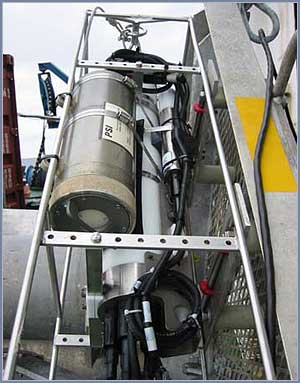
|
|

Craig McNeil
Senior Oceanographer
AIRS Department
Applied Physics Laboratory
University of Washington
Eric D'Asaro
Principal Oceanographer
AIRS Department
Applied Physics Laboratory
University of Washington
National Science Foundation
April 2006 – March 2011
|
A technical component of our hurricane project is the continued improvement of dissolved gas sensors for use on the APL mixed layer float (see Eric D'Asaro's website at APL-UW). During our prior grant we worked with Pro-Oceanus Systems, Inc. to modify their Gas Tension Device (GTD) for use on the float. In essence, the GTD measures total dissolved air pressure using a very precise pressure sensor. A gas permeable membrane equilibrator is used to equilibrate the dissolved gases with the sample volume of air in the pressure sensor. Because of our need for a fast response GTD with minimal size on the float, the original small round flat-surface membrane equilibrator of the GTD (Figures 1 and 2) was redesigned into a long tubular pumped equilibrator which wraps around the float (Figures 3 and 4). The new equilibrator design has a factor of 5 reduction in response time and was used successfully in Hurricane Frances deployments in 2004. Dissolved N2 can be estimated using simultaneous measurements of gas tension (dissolved air) dissolved O2, and seawater temperature and salinity. Because the GasFloat measures O2 and N2 simultaneously, we get much more detailed information on air-sea gas exchange processes than if only O2 was measured. Also, N2 is a good proxy for 'abiotic O2', and this allows us to separate physical and chemical processes from biological processes affecting dissolved gas distributions in the upper ocean. One drawback of the new GTD design is that is uses lots of power and this drains the float's batteries. The primary power drain is the pump on the membrane equilibrator. We have recently modified the system again to allow the float to duty cycle (pulse) the pump. By turning the pump on and off with a repeatable cycle, say 1 second on and 4 seconds off, we can save 80% on power consumption but increase response time by only a factor of 2. This provides much more flexibility for long duration sampling. We have implemented this power saving mode on all new floats for deployment in the upcoming 2008 hurricane season. References McNeil, C.L., E. D'Asaro, B.D. Johnson, and M. Horn, A gas tension device with response times of minutes, Journal of Atmospheric and Oceanic Technology, 23(11), 1539-1558, 2006. McNeil, C.L., and E.A. D'Asaro, Parameterization of air-sea gas exchange at extreme wind speeds, Journal of Marine Systems, 66, 110-121, 2007. D'Asaro, E.A., and C.L. McNeil, Air-sea gas exchange at extreme wind speeds measured by autonomous oceanographic floats, Journal of Marine Systems, 66, 92-109, 2007. |




|